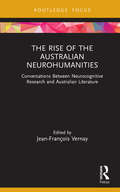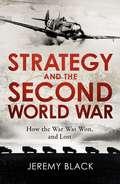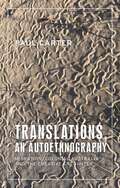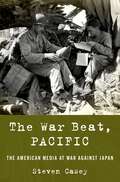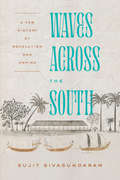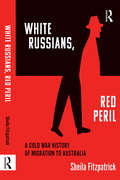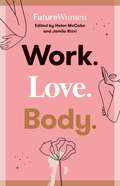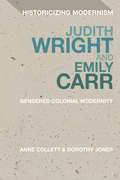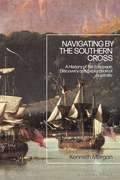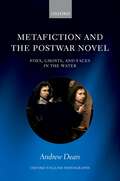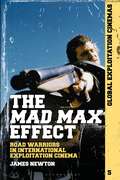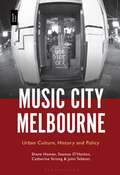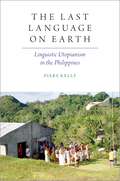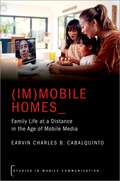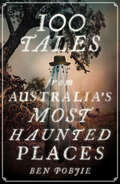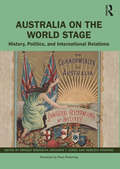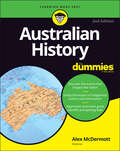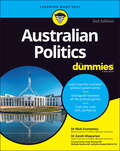- Table View
- List View
The Rise of the Australian Neurohumanities: Conversations Between Neurocognitive Research and Australian Literature (Routledge Focus on Literature)
by Jean-François VernayThis exciting one-of-a-kind volume brings together new contributions by geographically diverse authors who range from early career researchers to well-established scholars in the field. It unprecedentedly showcases a wide variety of the latest research at the intersection of Australian literary studies and cognitive literary studies in a single volume. It takes Australian fiction on the leading edge by paving the way for a new direction in Australian literary criticism.
Strategy and the Second World War: How the War was Won, and Lost
by Jeremy BlackA concise, accessible account of strategy and the Second World War. How the war was won . . . and lost..In 1941, the Second World War became global, when Nazi Germany attacked the Soviet Union; Japan attacked the United States at Pearl Harbor; and Germany declared war on the United States.In this timely book, which fills a real gap, Black engages with the strategic issues of the time - as they developed chronologically, and interacted - and relates these to subsequent debates about the choices made, revealing their continued political resonances.Beginning with Appeasement and the Soviet-German pact as key strategic means, Black examines the consequences of the fall of France for the strategies of all the powers. He shows how Allied strategy-making was more effective at the Anglo-American level than with the Soviet Union, not only for ideological and political reasons, but also because the Americans and British had a better grasp of the global dimension.He explores how German and Japanese strategies evolved as the war went badly for the Axis powers, and discusses the extent to which seeking to mould the post-war world informed Allied strategic choices from 1943 onwards, and the role these played in post-war politics, notably in the Cold War. Strategy was a crucial tool not only for conducting the war; it remains the key to understanding it today.
Translations, an autoethnography: Migration, colonial Australia and the creative encounter (Anthropology, Creative Practice and Ethnography)
by Paul CarterTranslations is a personal history written at the intersection of colonial anthropology, creative practice and migrant ethnography. Renowned postcolonial scholar, public artist and radio maker, UK-born Paul Carter documents and discusses a prodigiously varied and original trajectory of writing, sound installation and public space dramaturgy produced in Australia to present the phenomenon of contemporary migration in an entirely new light. Migrant space-time, Carter argues, is not linear, but turbulent, vortical and opportunistic. Before-and-after narratives fail to capture the work of self-becoming and serve merely to perpetuate colonialist fantasies. The ‘mirror state’ relationship between England and Australia, its structurally symmetrical histories of land theft and internal colonisation, repress the appearance of new subjects and subject relations. Reflecting on collaborations with Aboriginal artists, Carter argues for a new definition of the stranger-host relationship predicated on recognition of Aboriginal sovereignty. Carter calls the creative practice that breaks the cycle of repeated invasion ‘dirty art’. Translations is a passionately eloquent argument for reframing borders as crossing-places: framing less murderous exchange rates, symbolic literacy, creative courage and, above all, the emergence of a resilient migrant poetics will be essential.
Translations, an autoethnography: Migration, colonial Australia and the creative encounter (Anthropology, Creative Practice and Ethnography)
by Paul CarterTranslations is a personal history written at the intersection of colonial anthropology, creative practice and migrant ethnography. Renowned postcolonial scholar, public artist and radio maker, UK-born Paul Carter documents and discusses a prodigiously varied and original trajectory of writing, sound installation and public space dramaturgy produced in Australia to present the phenomenon of contemporary migration in an entirely new light. Migrant space-time, Carter argues, is not linear, but turbulent, vortical and opportunistic. Before-and-after narratives fail to capture the work of self-becoming and serve merely to perpetuate colonialist fantasies. The ‘mirror state’ relationship between England and Australia, its structurally symmetrical histories of land theft and internal colonisation, repress the appearance of new subjects and subject relations. Reflecting on collaborations with Aboriginal artists, Carter argues for a new definition of the stranger-host relationship predicated on recognition of Aboriginal sovereignty. Carter calls the creative practice that breaks the cycle of repeated invasion ‘dirty art’. Translations is a passionately eloquent argument for reframing borders as crossing-places: framing less murderous exchange rates, symbolic literacy, creative courage and, above all, the emergence of a resilient migrant poetics will be essential.
The War Beat, Pacific: The American Media at War Against Japan
by Steven CaseyThe definitive history of American war reporting in the Pacific theater of World War II, from the attack on Pearl Harbor to the atomic bombings of Hiroshima and Nagasaki. After almost two years slogging with infantrymen through North Africa, Italy, and France, Ernie Pyle immediately realized he was ill-prepared for covering the Pacific War. As Pyle and other war correspondents discovered, the climate, the logistics, and the sheer scope of the Pacific theater had no parallel in the war America was fighting in Europe. From Pearl Harbor to Hiroshima and Nagasaki, The War Beat, Pacific provides the first comprehensive account of how a group of highly courageous correspondents covered America's war against Japan, what they witnessed, what they were allowed to publish, and how their reports shaped the home front's perception of some of the most pivotal battles in American military history. In a dramatic and fast-paced narrative based on a wealth of previously untapped primary sources, Casey takes us from MacArthur's doomed defense on the Philippines and the navy's overly strict censorship policy at the time of Midway, through the bloody battles on Guadalcanal, New Guinea, Tarawa, Saipan, Leyte and Luzon, Iwo Jima and Okinawa, detailing the cooperation, as well as conflict, between the media and the military, as they grappled with the enduring problem of limiting a free press during a period of extreme crisis. The War Beat, Pacific shows how foreign correspondents ran up against practical challenges and risked their lives to get stories in a theater that was far more challenging than the war against Nazi Germany, while the US government blocked news of the war against Japan and tried to focus the home front on Hitler and his atrocities.
Waves Across the South: A New History of Revolution and Empire
by Sujit SivasundaramThis is a story of tides and coastlines, winds and waves, islands and beaches. It is also a retelling of indigenous creativity, agency, and resistance in the face of unprecedented globalization and violence. Waves Across the South shifts the narrative of the Age of Revolutions and the origins of the British Empire; it foregrounds a vast southern zone that ranges from the Arabian Sea and southwest Indian Ocean across to the Bay of Bengal, and onward to the South Pacific and the Tasman Sea. As the empires of the Dutch, French, and especially the British reached across these regions, they faced a surge of revolutionary sentiment. Long-standing venerable Eurasian empires, established patterns of trade and commerce, and indigenous practice also served as a context for this transformative era. In addition to bringing long-ignored people and events to the fore, Sujit Sivasundaram opens the door to new and necessary conversations about environmental history, the consequences of historical violence, the legacies of empire, the extraction of resources, and the indigenous futures that Western imperialism cut short. The result is nothing less than a bold new way of understanding our global past, one that also helps us think afresh about our shared future.
Waves Across the South: A New History of Revolution and Empire
by Sujit SivasundaramThis is a story of tides and coastlines, winds and waves, islands and beaches. It is also a retelling of indigenous creativity, agency, and resistance in the face of unprecedented globalization and violence. Waves Across the South shifts the narrative of the Age of Revolutions and the origins of the British Empire; it foregrounds a vast southern zone that ranges from the Arabian Sea and southwest Indian Ocean across to the Bay of Bengal, and onward to the South Pacific and the Tasman Sea. As the empires of the Dutch, French, and especially the British reached across these regions, they faced a surge of revolutionary sentiment. Long-standing venerable Eurasian empires, established patterns of trade and commerce, and indigenous practice also served as a context for this transformative era. In addition to bringing long-ignored people and events to the fore, Sujit Sivasundaram opens the door to new and necessary conversations about environmental history, the consequences of historical violence, the legacies of empire, the extraction of resources, and the indigenous futures that Western imperialism cut short. The result is nothing less than a bold new way of understanding our global past, one that also helps us think afresh about our shared future.
"White Russians, Red Peril": A Cold War History of Migration to Australia
by Sheila FitzpatrickOver 20,000 ethnic Russians migrated to Australia after World War II – yet we know very little about their experiences. Some came via China, others from refugee camps in Europe. Many preferred to keep a low profile in Australia, and some attempted to ‘pass’ as Polish, West Ukrainian or Yugoslavian. They had good reason to do so: to the Soviet Union, Australia’s resettling of Russians amounted to the theft of its citizens, and undercover agents were deployed to persuade them to repatriate. Australia regarded the newcomers with wary suspicion, even as it sought to build its population by opening its door to more immigrants. Making extensive use of newly discovered Russian-language archives and drawing on a lifetime’s study of Soviet history and politics, award-winning author Sheila Fitzpatrick examines the early years of a diverse and disunited Russian-Australian community and how Australian and Soviet intelligence agencies attempted to track and influence them. While anti-Communist ‘White’ Russians dreamed a war of liberation would overthrow the Soviet regime, a dissident minority admired its achievements and thought of returning home.
"White Russians, Red Peril": A Cold War History of Migration to Australia
by Sheila FitzpatrickOver 20,000 ethnic Russians migrated to Australia after World War II – yet we know very little about their experiences. Some came via China, others from refugee camps in Europe. Many preferred to keep a low profile in Australia, and some attempted to ‘pass’ as Polish, West Ukrainian or Yugoslavian. They had good reason to do so: to the Soviet Union, Australia’s resettling of Russians amounted to the theft of its citizens, and undercover agents were deployed to persuade them to repatriate. Australia regarded the newcomers with wary suspicion, even as it sought to build its population by opening its door to more immigrants. Making extensive use of newly discovered Russian-language archives and drawing on a lifetime’s study of Soviet history and politics, award-winning author Sheila Fitzpatrick examines the early years of a diverse and disunited Russian-Australian community and how Australian and Soviet intelligence agencies attempted to track and influence them. While anti-Communist ‘White’ Russians dreamed a war of liberation would overthrow the Soviet regime, a dissident minority admired its achievements and thought of returning home.
Work. Love. Body.: Future Women
by Jamila Rizvi Helen McCabeIn 2020, the lives of Australian women changed irrevocably. With insight, intelligence and empathy, Jane Gilmore, Santilla Chingaipe and Emily J. Brooks explore this through the lenses of work, love and body, and ask: Will the Australia of tomorrow be more equal than the one we were born into? Or will women and girls remain left behind?While our country was shrouded in smoke in the early months of 2020, Australian women went about their daily business. They worked, studied, cleaned, did school runs, made meals. And they postponed looking after themselves because life got in the way.Then, in March, Australians were told to lock down. For all the talk of equality, it was primarily women who held the health of our communities in their hands as they took on the essential jobs to care, to nurse and to teach, despite an invisible danger. One year later, women across the country would march on behalf of those who were not safe in workplaces and their own homes.Never before has change been thrust so abruptly on modern Australian women - 2020 impacted our working lives, relationships and our health and wellbeing. And as a growing number of women agitate for change, it is time to demand what women want. So where do we go from here?One thing is very clear: the future is now, and it is female.
Judith Wright and Emily Carr: Gendered Colonial Modernity (Historicizing Modernism)
by Anne Collett Dorothy JonesKnitting together two fascinating but entirely distinct lives, this ingeniously structured braided biography tells the story of the lives and work of two women, each a cultural icon in her own country yet lesser known in the other's. Australian poet Judith Wright and Canadian painter Emily Carr broke new ground for female artists in the British colonies and influenced the political and social debates about environment and indigenous rights that have shaped Australia and Canada in the 21st century. In telling their story/ies, this book charts the battle for recognition of their modernist art and vision, pointing out significant moments of similarity in their lives and work. Although separated by thousands of miles, their experience of colonial modernity was startlingly analogous, as white settler women bent on forging artistic careers in a male-dominated world and sphere rigged against them. Through all this, though, their cultural importance endures; two remarkable women whose poetry and painting still speak to us today of their passionate belief in the transformative power of art.
Navigating by the Southern Cross: A History of the European Discovery and Exploration of Australia
by Kenneth MorganIn this comprehensive study, Kenneth Morgan provides an authoritative account of European exploration and discovery in Australia. The book presents a detailed chronological overview of European interests in the Australian continent, from initial speculations about the 'Great Southern Land' to the major hydrographic expeditions of the 19th century. In particular, he analyses the early crossings of the Dutch in the 17th century, the exploits of English 'buccaneer adventurer' William Dampier, the famous voyages of James Cook and Matthew Flinders, and the little-known French annexation of Australia in 1772. Introducing new findings and drawing on the latest in historiographical research, this book situates developments in navigation, nautical astronomy and cartography within the broader contexts of imperial, colonial, and maritime history.
Metafiction and the Postwar Novel: Foes, Ghosts, and Faces in the Water (Oxford English Monographs)
by Andrew DeanMetafiction and the Postwar Novel is a full-length reassessment of one of the definitive literary forms of the postwar period, sometimes known as 'postmodern metafiction'. In the place of large-scale theorizing, this book centres on the intimacies of writing situations - metafiction as it responds to readers, literary reception, and earlier works in a career. The emergence of archival materials and posthumously published works helps to bring into view the stakes of different moments of writing. It develops new terms for discussing literary self-reflexivity, derived from a reading of Don Quixote and its reception by J.L. Borges - the 'self of writing' and the 'public author as signature'. Across three comprehensive chapters, Metafiction and Postwar Fiction shows how some of the most highly-regarded postwar writers were motivated to incorporate reflexive elements into their writing - and to what ends. The first chapter, on South African novelist J. M. Coetzee, shows with a new clarity how his fictions drew from and relativized academic literary theory and the conditions of writing in apartheid South Africa. The second chapter, on New Zealand writer Janet Frame, draws widely from her fictions, autobiographies, and posthumously published materials. It demonstrates the terms in which her writing addresses a readership seemingly convinced that her work expressed the interior experience of 'madness'. The final chapter, on American writer Philip Roth, shows how his early reception led to his later, and often explosive, reconsiderations of identity and literary value in postwar America.
The War Beat, Pacific: The American Media at War Against Japan
by Steven CaseyThe definitive history of American war reporting in the Pacific theater of World War II, from the attack on Pearl Harbor to the atomic bombings of Hiroshima and Nagasaki. After almost two years slogging with infantrymen through North Africa, Italy, and France, Ernie Pyle immediately realized he was ill-prepared for covering the Pacific War. As Pyle and other war correspondents discovered, the climate, the logistics, and the sheer scope of the Pacific theater had no parallel in the war America was fighting in Europe. From Pearl Harbor to Hiroshima and Nagasaki, The War Beat, Pacific provides the first comprehensive account of how a group of highly courageous correspondents covered America's war against Japan, what they witnessed, what they were allowed to publish, and how their reports shaped the home front's perception of some of the most pivotal battles in American military history. In a dramatic and fast-paced narrative based on a wealth of previously untapped primary sources, Casey takes us from MacArthur's doomed defense on the Philippines and the navy's overly strict censorship policy at the time of Midway, through the bloody battles on Guadalcanal, New Guinea, Tarawa, Saipan, Leyte and Luzon, Iwo Jima and Okinawa, detailing the cooperation, as well as conflict, between the media and the military, as they grappled with the enduring problem of limiting a free press during a period of extreme crisis. The War Beat, Pacific shows how foreign correspondents ran up against practical challenges and risked their lives to get stories in a theater that was far more challenging than the war against Nazi Germany, while the US government blocked news of the war against Japan and tried to focus the home front on Hitler and his atrocities.
The Mad Max Effect: Road Warriors in International Exploitation Cinema (Global Exploitation Cinemas)
by James NewtonThe Mad Max Effect provides an in-depth analysis of the Mad Max series, and how it began as an inventive concoction ofa number of influences from a range of exploitation genres (including the biker movie, the revenge film, and the car chasecinema of the 1970s), to eventually inspiring a fresh cycle of international low budget 'road warrior' movies that appeared on home video in the 1980s.The Mad Max Effect is the first detailed academic study of the most famous and celebrated post-apocalypse film series, andexamines how a humble Australian action movie came from the cultural margins of exploitation cinema to have a profound impact on the broader media landscape.
Music City Melbourne: Urban Culture, History and Policy
by Shane Homan Seamus O’Hanlon Catherine Strong John TebbuttHow did Melbourne earn its place as one of the world's 'music cities'? Beginning with the arrival of rock 'n' roll in the 1950s, this book explores the development of different sectors of Melbourne's popular music ecosystem in parallel with broader population, urban planning and media industry changes in the city. The authors draw on interviews with Melbourne musicians, venue owners and policy-makers, documenting their ambitions and experiences across different periods, with accompanying spotlights on the gendered, multicultural and indigenous contexts of playing and recording in Melbourne. Focusing on pop and rock, this is the first book to provide an extensive historical lens of popular music within an urban cultural economy that in turn investigates the contemporary nature and challenges of urban music activities and policy.
The Last Language on Earth: Linguistic Utopianism in the Philippines (Oxford Studies in the Anthropology of Language)
by Piers KellyThe Last Language on Earth is an ethnographic history of the disputed Eskayan language, spoken today by an isolated upland community living on the island of Bohol in the southern Philippines. After Eskaya people were first 'discovered' in 1980, visitors described the group as a lost tribe preserving a unique language and writing system. Others argued that the Eskaya were merely members of a utopian rural cult who had invented their own language and script. Rather than adjudicating outsider polemics, this book engages directly with the language itself as well as the direct perspectives of those who use it today. Through written and oral accounts, Eskaya people have represented their language as an ancestral creation derived from a human body. Reinforcing this traditional view, Piers Kelly's linguistic analysis shows how a complex new register was brought into being by fusing new vocabulary onto a modified local grammar. In a synthesis of linguistic, ethnographic, and historical evidence, a picture emerges of a coastal community that fled the ravages of the U.S. invasion of the island in 1901 in order to build a utopian society in the hills. Here they predicted that the world's languages would decline leaving Eskayan as the last language on earth. Marshalling anthropological theories of nationalism, authenticity, and language ideology, along with comparisons to similar events across highland Southeast Asia, Kelly offers a convincing account of this linguistic mystery and also shows its broader relevance to linguistic anthropology. Although the Eskayan situation is unusual, it has the power to illuminate the pivotal role that language plays in the pursuit of identity-building and political resistance.
**Missing**: Family Life at a Distance in the Age of Mobile Media (Studies in Mobile Communication)
by Earvin Charles CabalquintoThe home has been on the forefront of rapid economic, political, social, and technological transformations for many individuals and families across the world. As a country reliant on the exportation of human labor to sustain its national economy, the Philippines exemplifies a valuable case study of the impacts of a globalized and networked society on the everyday dynamics of a transnational family arrangement. Despite ranking among the heaviest Internet users in the world, Filipino citizens are often left with no choice but to navigate digital and transnational environments orchestrated by the uneven distribution of both national and international resources and opportunities. (Im)mobile Homes investigates the role of smartphones, social media channels, and various mobile applications in forging and sustaining intimate ties among dispersed Filipino family members. Examining the digital lifeworlds of transnational Filipino family in Australia, this volume draws on rich ethnographic study to explore the benefits of digital communication as well as the tensions enabled by the influences of socio-cultural structures, socio-economic conditions, technological affordances, and institutional policies and processes on mobile practices. It portrays the physically distributed yet virtually connected nature of the transnational Filipino family through diverse contexts, such as observing family rituals, performing intimate care, and managing crises, and foregrounds their unique strategies in addressing the interruptions of connecting at a distance. Ultimately, this volume underscores how mobile practices of the transnational Filipino family negotiate the pre-existing and broader structural systems that (re)produce marginalization in a digital and global era. Enriched by moving stories of transnational families, (Im)mobile Homes offers a critical lens towards interrogating the possibilities and politics of a home from afar in the digital era.
100 Tales from Australia's Most Haunted Places
by Ben PobjieFrom the ghostly black horse of Sutton Forest to the butcher of Adelaide Street, a haunted Brisbane lift to the chilling experiments carried out by Doctor Blood of the North Kapunda Hotel, Australia abounds in spooky stories that are all unnervingly based in fact and tied to real places you can visit or avoid. In 100 Tales from Australia's Most Haunted Places, comedy writer and general scaredy-cat Ben Pobjie communes with the spirit world to send a shiver down your spine. A book best read with the light left on.
Australia on the World Stage: History, Politics, and International Relations
by Bridget Brooklyn Benjamin T. Jones Rebecca StratingAustralia on the World Stage: History, Politics, and International Relations offers a fresh examination of Australia’s past and present. From the complex interactions of First Nations to modern international relations with significant partners and allies, it examines the forces that have influenced the place now called Australia both historically and today. It is a unique history told in two parts. The first half of the book examines the way Australia acted on the world stage both before and after British colonisation. It outlines the evolution of Australia’s relationship with the United Kingdom, first as colonies, then a dominion, and finally as an independent nation. It finishes with a First Nations perspective on foreign relations. The second half of the book provides a wide-ranging history of Australia’s dealings with major powers, the United States and China, as well as its relationships with New Zealand, Aotearoa, the Pacific Islands, Indonesia, Japan, Antarctica, and the United Nations. Written by leading and emerging researchers in their fields, this book encourages the reader to consider Australia’s performance on the world stage over the longue durée, well before the word ‘Australia’ was ever dreamt up. This interdisciplinary work challenges lazy stereotypes that see Australia's international history as fixed and uncontested. In revisiting Australia’s foreign relations, this work also asks the reader to consider its future directions.
Australia on the World Stage: History, Politics, and International Relations
by Bridget Brooklyn Benjamin T. Jones Rebecca StratingAustralia on the World Stage: History, Politics, and International Relations offers a fresh examination of Australia’s past and present. From the complex interactions of First Nations to modern international relations with significant partners and allies, it examines the forces that have influenced the place now called Australia both historically and today. It is a unique history told in two parts. The first half of the book examines the way Australia acted on the world stage both before and after British colonisation. It outlines the evolution of Australia’s relationship with the United Kingdom, first as colonies, then a dominion, and finally as an independent nation. It finishes with a First Nations perspective on foreign relations. The second half of the book provides a wide-ranging history of Australia’s dealings with major powers, the United States and China, as well as its relationships with New Zealand, Aotearoa, the Pacific Islands, Indonesia, Japan, Antarctica, and the United Nations. Written by leading and emerging researchers in their fields, this book encourages the reader to consider Australia’s performance on the world stage over the longue durée, well before the word ‘Australia’ was ever dreamt up. This interdisciplinary work challenges lazy stereotypes that see Australia's international history as fixed and uncontested. In revisiting Australia’s foreign relations, this work also asks the reader to consider its future directions.
Australian History For Dummies
by Alex McDermottExplore the land down under with your friends at Dummies Australia might be most famous for kangaroos, koalas, friendly people, and decidedly unfriendly critters (like the black widow spider, yikes!), but did you know that its government was dismissed by the British Crown in 1975? Or that human beings have lived on the continent for around 65,000 years? In Australian History For Dummies, you???ll discover all that ??? and more ??? as you discover the history of Indigenous Australians, colonial explorers, and the modern inhabitants of one of the most fascinating nations, islands, and continents in the world today!
Australian History For Dummies
by Alex McDermottExplore the land down under with your friends at Dummies Australia might be most famous for kangaroos, koalas, friendly people, and decidedly unfriendly critters (like the black widow spider, yikes!), but did you know that its government was dismissed by the British Crown in 1975? Or that human beings have lived on the continent for around 65,000 years? In Australian History For Dummies, you???ll discover all that ??? and more ??? as you discover the history of Indigenous Australians, colonial explorers, and the modern inhabitants of one of the most fascinating nations, islands, and continents in the world today!
Australian Politics For Dummies
by Nick Economou Zareh GhazarianUnderstand Aussie politics and make your vote count! Australian Politics For Dummies gives you a helping hand as you get to grips with the good, the bad and the ugly of Australian politics. Seasoned political punters and voting novices alike will find fascinating facts and top thrills in in this essential guide. Master the ins and outs of elections, parties and policies. In no time, you'll be discussing and debating the biggest issues with ease. Down under, we all have to vote. It's one of the many beautiful things about this land of ours, and this book will help you learn why (and how) to cast that ballot. This updated edition gives you everything you need to cast your vote with confidence. You'll identify what makes the Australian political system tick, distinguish between the different political parties and understand the influence of the media in Australian politics. Decipher political terminology, make sense of the houses of parliament and understand why we have minor parties Learn how Australia's political system evolved and grasp today's voting systems Make sense of coalition politics and figure out the differences between the Labor and Liberal parties Find out why Australia's system of government is described as 'Washminster,' and discover the Whips and the Usher of the Black Rod You want to know more about Australian politics, but, if we're being realistic, it's very complicated. Australian Politics For Dummies clears it all up.
Australian Politics For Dummies
by Nick Economou Zareh GhazarianUnderstand Aussie politics and make your vote count! Australian Politics For Dummies gives you a helping hand as you get to grips with the good, the bad and the ugly of Australian politics. Seasoned political punters and voting novices alike will find fascinating facts and top thrills in in this essential guide. Master the ins and outs of elections, parties and policies. In no time, you'll be discussing and debating the biggest issues with ease. Down under, we all have to vote. It's one of the many beautiful things about this land of ours, and this book will help you learn why (and how) to cast that ballot. This updated edition gives you everything you need to cast your vote with confidence. You'll identify what makes the Australian political system tick, distinguish between the different political parties and understand the influence of the media in Australian politics. Decipher political terminology, make sense of the houses of parliament and understand why we have minor parties Learn how Australia's political system evolved and grasp today's voting systems Make sense of coalition politics and figure out the differences between the Labor and Liberal parties Find out why Australia's system of government is described as 'Washminster,' and discover the Whips and the Usher of the Black Rod You want to know more about Australian politics, but, if we're being realistic, it's very complicated. Australian Politics For Dummies clears it all up.
